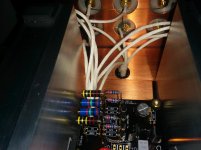And I will take the opportunity to remind you of posts 10 & 16.AndrewT
Please read posts #52,53 and 62-65. I am open minded to take measurements as suggested by BigE.............................. You rely on people's senses. Because they tell more then your measurements.
Hello all
This isn't really on the topic of sonic improvements and is a pretty basic question but I picked up a second hand Teabag kit and have populated the board with resistors but I seem to have two options for the large resistors in front of the filter caps where the board says "10/5W" - either 10 ohm or 5 ohm. Because 10 ohm seems to be on the BOM I'll put those in but what difference would the 5 ohm ones make?
Thanks
This isn't really on the topic of sonic improvements and is a pretty basic question but I picked up a second hand Teabag kit and have populated the board with resistors but I seem to have two options for the large resistors in front of the filter caps where the board says "10/5W" - either 10 ohm or 5 ohm. Because 10 ohm seems to be on the BOM I'll put those in but what difference would the 5 ohm ones make?
Thanks
5 Ohm boosts the current and dissipation in the MOSFETS more than with 10 Ohm, a thing which many find subjectively more rewarding. Still, 10/5W just means 10 Ohm 5W resistors which represents a good amount of running current for most users.
Salas, thank you very much for the very quick reply. I spent ages looking for an answer but perhaps the question was a bit basic and obvious. I'll start with 10 and maybe have a play at a later date.
After too loooonnnng a time, my Hotrodded DCB1 is almost finished (me, my wife and my two kids were away for the last 3 months on a trip troughout North America covering almost all of Canada and USA....great memories for the rest of our life). Got back in September...
Anyway, I posted pics of my build Hotrodded version on the ''Salas hot-rodded blue DCB1 build'' thread
Resistor tryouts are about to begin.
Thanks all for the ultra long wait. I will post results of components swapping here.
Regards
Scorpion
Anyway, I posted pics of my build Hotrodded version on the ''Salas hot-rodded blue DCB1 build'' thread
Resistor tryouts are about to begin.
Thanks all for the ultra long wait. I will post results of components swapping here.
Regards
Scorpion
Hi all,
OK done thing...at last, after months.... I will start the resistors swap and report the results here.
There is close to 200 hours of continuous music playing so "burning" is not fully done. I usually consider gears fully "burned" after 500-1000 hours (where the sound usually doesn't "move"at all). Still, I will start the swaps at around 300-350 hours.
In the meantime, I will build a device to give the resistors to be tried some burn in time " on the side". This way, when it will be time to put them in, they won't be "new"...
Salas and/or AndrewT, you guys know how limited my technical/electrical knowledge is, but, I had the following thoughts for the "burning device ":
Transfo>>bridge>>resistors in parallel>>load (light bulbs ???)
My concern is that by paralleling so many resistors at once, I will end up with very low resistance...
I don't know, I don't have sufficient knowledge.
Please guide me or link me to a thread that takes care of the matter.
Sincere regards
Scorpion
OK done thing...at last, after months.... I will start the resistors swap and report the results here.
There is close to 200 hours of continuous music playing so "burning" is not fully done. I usually consider gears fully "burned" after 500-1000 hours (where the sound usually doesn't "move"at all). Still, I will start the swaps at around 300-350 hours.
In the meantime, I will build a device to give the resistors to be tried some burn in time " on the side". This way, when it will be time to put them in, they won't be "new"...
Salas and/or AndrewT, you guys know how limited my technical/electrical knowledge is, but, I had the following thoughts for the "burning device ":
Transfo>>bridge>>resistors in parallel>>load (light bulbs ???)
My concern is that by paralleling so many resistors at once, I will end up with very low resistance...
I don't know, I don't have sufficient knowledge.
Please guide me or link me to a thread that takes care of the matter.
Sincere regards
Scorpion
Last edited:
I have never heard a resistor "burn in". It does what it does: resists current flow, nothing more. What is supposed to happen with resistor "burn in"? Does it's resistance change?
Don't worry about burn in.
Don't worry about burn in.
I have never heard a resistor "burn in". It does what it does: resists current flow, nothing more. What is supposed to happen with resistor "burn in"? Does it's resistance change?
Don't worry about burn in.
BigE,
If you have ever compared the sound of a new capacitor vs one wich has hundreds and hundreds of hours of music (signal) playing, then you know what I am talking about.
Same goes for resistors altough they (in my experience) require less time...
If you haven't experienced it, then...
Thanks
Regards
Scorpion
BTW, here are a few pics of my 99% finished DCB1
Starting resistor kits: 220R Shinkoh Tantalum, 1M Riken Ohms, 220K Allen-Bradley.
Starting resistor kits: 220R Shinkoh Tantalum, 1M Riken Ohms, 220K Allen-Bradley.
Attachments
-
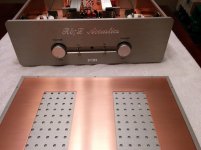 IMG_20141019_224635.jpg465.1 KB · Views: 627
IMG_20141019_224635.jpg465.1 KB · Views: 627 -
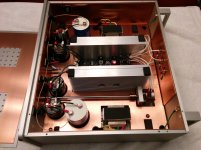 IMG_20141019_224706.jpg564.6 KB · Views: 633
IMG_20141019_224706.jpg564.6 KB · Views: 633 -
 IMG_20141019_224715.jpg702.6 KB · Views: 625
IMG_20141019_224715.jpg702.6 KB · Views: 625 -
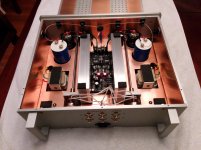 IMG_20141019_224724.jpg673.2 KB · Views: 604
IMG_20141019_224724.jpg673.2 KB · Views: 604 -
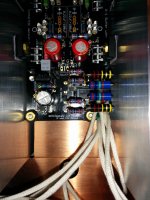 IMG_20141019_224820.jpg493.4 KB · Views: 585
IMG_20141019_224820.jpg493.4 KB · Views: 585 -
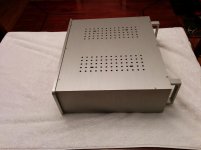 IMG_20141019_230527.jpg457.7 KB · Views: 284
IMG_20141019_230527.jpg457.7 KB · Views: 284 -
 IMG_20141019_230553.jpg458.1 KB · Views: 220
IMG_20141019_230553.jpg458.1 KB · Views: 220 -
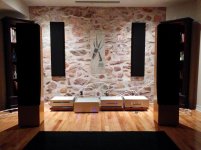 IMG_20141019_234251.jpg609.4 KB · Views: 297
IMG_20141019_234251.jpg609.4 KB · Views: 297 -
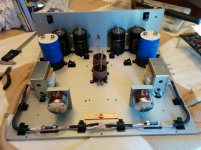 IMG_20140909_161446.jpg592 KB · Views: 323
IMG_20140909_161446.jpg592 KB · Views: 323
Last edited:
NEW DCB1 = NO MORE SEX
Hi all,
Ok, let's start the tests.
I don't consider my DCB1 as fully ''burned in'' as it has around 350-400 hours of continuous music playing as of now. My past experiences have shown me that subtle changes in sound usually fully stabilise after anywhere between 500-1000 hours. Still, I got to admit that the sound has been pretty stable in the last 50 hours or so with very tiny gains in image stability, impact of bass, air around the instruments and slightly better harmonics, more details with tamer treble.
Still, we are talking tiny differences.
The initial resistors are:
Shinkoh Tantalum 220R @ 1/2W
Riken Ohms 1Mega @ 1W
NOS Allen-Bradley 220K (230K after drift) @ 1W
Overall, the sound of my DCB1 is very musical and pleasant. We can feel the ''soul'' of individual performances. There is something magic about it.
So much so that the WAF (Wife Acceptance Factor) is turning against me !!! My wife doesn't want to have sex anymore !!! She spends her free time listening to new music she bought or rediscovering her favorite CDs as soon as she get's spare time !!! If only I had known...!!! 😉
Now, back to the sound. Tone wise, the sound is very natural. The voices are human and realistic, guitars have natural overtones with excellent harmonics. Same goes with cello, piano, violin, harp and acoustic guitars. What sets the sound apart is the high musicality and naturalness of timbres and the fact that you can feel the ''uniqueness'' of every performance.
But, I have to say that even if it sounds addictive, my DCB1 needs further fine-tuning.
I read several times fellow DCB1 builders rave about the sheer transparency of the unit but in fact, for me, it is ---with the actual resistors trio -- a step back in transparency. I was using a passive preamp made by DIY Audio member Praudio, and it was a good notch more transparent than the DCB1. Don't get me wrong, the DCB1 is transparent, just not as much. I don't feel as much air around instruments, the background is not as black, I don't have the same finesse and the edges of instruments are not as delineated as I was used to. There is some sort of ''halo'' around instruments which I can't live with. The bass goes deep but is a little ''round'' if you know what I mean. The sound is full but slightly bigger than it should be. In fact. there is something a little ''vintage'' in the sound yet it is very very pleasant.
But, my DCB1 is way more organic sounding, natural and supremely more musical than my old passive pre. Soundstage is also more expansive, bass goes way deeper and the sound has more density.
Now, I suspect the Allen-Bradleys carbon comp@ 220K to be contributors to the slightly ''vintage sound''.
Since I have A LOOOTTTT of 220Ks to try, let's change these first and see what happens.
I will always A-B-A my swaps in order to get a better idea of the changes, should there be any.
Let's begin.
Regards
Scorpion
Hi all,
Ok, let's start the tests.
I don't consider my DCB1 as fully ''burned in'' as it has around 350-400 hours of continuous music playing as of now. My past experiences have shown me that subtle changes in sound usually fully stabilise after anywhere between 500-1000 hours. Still, I got to admit that the sound has been pretty stable in the last 50 hours or so with very tiny gains in image stability, impact of bass, air around the instruments and slightly better harmonics, more details with tamer treble.
Still, we are talking tiny differences.
The initial resistors are:
Shinkoh Tantalum 220R @ 1/2W
Riken Ohms 1Mega @ 1W
NOS Allen-Bradley 220K (230K after drift) @ 1W
Overall, the sound of my DCB1 is very musical and pleasant. We can feel the ''soul'' of individual performances. There is something magic about it.
So much so that the WAF (Wife Acceptance Factor) is turning against me !!! My wife doesn't want to have sex anymore !!! She spends her free time listening to new music she bought or rediscovering her favorite CDs as soon as she get's spare time !!! If only I had known...!!! 😉
Now, back to the sound. Tone wise, the sound is very natural. The voices are human and realistic, guitars have natural overtones with excellent harmonics. Same goes with cello, piano, violin, harp and acoustic guitars. What sets the sound apart is the high musicality and naturalness of timbres and the fact that you can feel the ''uniqueness'' of every performance.
But, I have to say that even if it sounds addictive, my DCB1 needs further fine-tuning.
I read several times fellow DCB1 builders rave about the sheer transparency of the unit but in fact, for me, it is ---with the actual resistors trio -- a step back in transparency. I was using a passive preamp made by DIY Audio member Praudio, and it was a good notch more transparent than the DCB1. Don't get me wrong, the DCB1 is transparent, just not as much. I don't feel as much air around instruments, the background is not as black, I don't have the same finesse and the edges of instruments are not as delineated as I was used to. There is some sort of ''halo'' around instruments which I can't live with. The bass goes deep but is a little ''round'' if you know what I mean. The sound is full but slightly bigger than it should be. In fact. there is something a little ''vintage'' in the sound yet it is very very pleasant.
But, my DCB1 is way more organic sounding, natural and supremely more musical than my old passive pre. Soundstage is also more expansive, bass goes way deeper and the sound has more density.
Now, I suspect the Allen-Bradleys carbon comp@ 220K to be contributors to the slightly ''vintage sound''.
Since I have A LOOOTTTT of 220Ks to try, let's change these first and see what happens.
I will always A-B-A my swaps in order to get a better idea of the changes, should there be any.
Let's begin.
Regards
Scorpion
Attachments
DCB1: 220k resistor swaps...Allen-Bradleys to Amtrans
220R Shinkoh Tantalum-1Mega Riken Ohms-220K Allen-Bradley
Ok, after A-B-A ing of the Allen-Bradleys with the next 220Ks (Amtrans carbon film 3/4W), here is how I would describe the sound of the respective resistors.
Allen-Bradleys 220K @ 1W:
Very organic and natural sounding, warm sound. Highly coherent and musical. There is a rightness of tones and a ''togetherness'' of sound (instruments/musicians playing individually and yet together) which is very hard to describe but which can be felt. Very euphonic. The bass is powerful but ''round'' i.e not real tight. Timbers are superbly rich. Harmonics very good. Laid back voices, never ''in your face''.
But, there is a lack of crispness (as in not enough) to the overall sound especially notable on violin, piano and acoustic guitars. I just can't hear clearly enough the pinching of the guitars strings, the violinist rubbing its archer or the hammers hitting on piano tracks. Briefly, the edges are a little ''fuzzy''. The instruments are also a little too ''oversized'' compared to the real things. Silence around the instruments is average. In fact the background is a little noisy. For sure, not as pitch black as I am used to.
In resume, very musical, organic and euphonic sounding resistors but IMHO I consider them too colored. Maybe for guitar amps, or used sparingly in appropriate position but they do not fit in this current trio of resistors, at least not in the 220K positions.
220R Shinkoh Tantalum- 1Mega Riken Ohms- 220K Amtrans AMRG
Swapping from the Allen-Bradleys to the Amtrans, there are some noticeable differences.
The Amtrans are more precise and give you a little more details (without being analytical) than the Allen-Bradleys. The image is also more precise and sure enough not as big. The silences around instruments are better without a doubt ( lower noise floor???) and so is the finesse, but, I think it is because the Amtrans is more transparent and less colored than the A-Bs and therefore let me hear more of the gears upstream. The strings of violins and/or guitars are not as rich as with the A-B but the pinching is clearer. Percussions have a little more impact and snap. The bass is not as round as with the A-Bs and seem to go a tad lower (the A-Bs have a bass bloom half a notch above)...still the bass is not what I would call very tight. Voices are presented a little more upfront in the soundstage giving them a little more palpability. I liked it a lot. Timbres are not as rich as with the A-Bs and maybe because of that, the Amtrans harmonics seem to be very very recessed compared to the formers. Timbres are still very good though. Overall, they are not as euphonic as the Allen-Bradleys but nor are they as colored.
My wife complained that something was different, a little more aggressive sounding and not as musical (she was gone with the kids when I did the swap so she had no way of knowing what I did) when she got back home from a birthday party earlier today. That's as unbiased as can be...
I agree with her, in part. The Amtrans don't have the ''togetherness'' of sound that the A-Bs have. As I said, they are less euphonic but at the same time, they are more ''right sounding''. Personally, I don't find the Amtrans aggressive at all. Just more transparent. They are far from analytical.
Do I like the Amtrans better? I don't know. I will give them more time to burn in to see where it leads (if anywhere). The Allen-Bradleys with their rich, musical and euphonic sound go straight for the heart but as soon as you start to notice the flaws, you go: Noooo Way !!! The Amtrans are half-heart half-brain: they sound more right, the flaws are fewer but they just don't caress you as much...
Let's wait a little and see.
Regards
Scorpion
220R Shinkoh Tantalum-1Mega Riken Ohms-220K Allen-Bradley
Ok, after A-B-A ing of the Allen-Bradleys with the next 220Ks (Amtrans carbon film 3/4W), here is how I would describe the sound of the respective resistors.
Allen-Bradleys 220K @ 1W:
Very organic and natural sounding, warm sound. Highly coherent and musical. There is a rightness of tones and a ''togetherness'' of sound (instruments/musicians playing individually and yet together) which is very hard to describe but which can be felt. Very euphonic. The bass is powerful but ''round'' i.e not real tight. Timbers are superbly rich. Harmonics very good. Laid back voices, never ''in your face''.
But, there is a lack of crispness (as in not enough) to the overall sound especially notable on violin, piano and acoustic guitars. I just can't hear clearly enough the pinching of the guitars strings, the violinist rubbing its archer or the hammers hitting on piano tracks. Briefly, the edges are a little ''fuzzy''. The instruments are also a little too ''oversized'' compared to the real things. Silence around the instruments is average. In fact the background is a little noisy. For sure, not as pitch black as I am used to.
In resume, very musical, organic and euphonic sounding resistors but IMHO I consider them too colored. Maybe for guitar amps, or used sparingly in appropriate position but they do not fit in this current trio of resistors, at least not in the 220K positions.
220R Shinkoh Tantalum- 1Mega Riken Ohms- 220K Amtrans AMRG
Swapping from the Allen-Bradleys to the Amtrans, there are some noticeable differences.
The Amtrans are more precise and give you a little more details (without being analytical) than the Allen-Bradleys. The image is also more precise and sure enough not as big. The silences around instruments are better without a doubt ( lower noise floor???) and so is the finesse, but, I think it is because the Amtrans is more transparent and less colored than the A-Bs and therefore let me hear more of the gears upstream. The strings of violins and/or guitars are not as rich as with the A-B but the pinching is clearer. Percussions have a little more impact and snap. The bass is not as round as with the A-Bs and seem to go a tad lower (the A-Bs have a bass bloom half a notch above)...still the bass is not what I would call very tight. Voices are presented a little more upfront in the soundstage giving them a little more palpability. I liked it a lot. Timbres are not as rich as with the A-Bs and maybe because of that, the Amtrans harmonics seem to be very very recessed compared to the formers. Timbres are still very good though. Overall, they are not as euphonic as the Allen-Bradleys but nor are they as colored.
My wife complained that something was different, a little more aggressive sounding and not as musical (she was gone with the kids when I did the swap so she had no way of knowing what I did) when she got back home from a birthday party earlier today. That's as unbiased as can be...
I agree with her, in part. The Amtrans don't have the ''togetherness'' of sound that the A-Bs have. As I said, they are less euphonic but at the same time, they are more ''right sounding''. Personally, I don't find the Amtrans aggressive at all. Just more transparent. They are far from analytical.
Do I like the Amtrans better? I don't know. I will give them more time to burn in to see where it leads (if anywhere). The Allen-Bradleys with their rich, musical and euphonic sound go straight for the heart but as soon as you start to notice the flaws, you go: Noooo Way !!! The Amtrans are half-heart half-brain: they sound more right, the flaws are fewer but they just don't caress you as much...
Let's wait a little and see.
Regards
Scorpion
Attachments
A simple recording and a comparison with audiodiffmaker would go a long way. Audiodiffmaker is free BTW..
More experiments...
About the resistors waiting in line....
You will notice that I sometimes have same brand of resistors in same value but of different wattage. That's because some people report a difference in sound when upping the wattage. I don't know, I have never tried it nor experienced it before but I will give it a try to see if something happens
I do have Takman carbon film 1/4 and 1/2 watts, Takman metal film 1/4 and 1/2 watts and Allen-Bradleys 1/4 and 1 watts. Let's see if increasing wattage does make a difference in sound and if so, if a bigger increase changes something or not.
I also read people stating about changes in sound related to direction of signal. I don't know but I will also give it a try. For this, I will '' burn in'' 2 matched pair of 220K resistors in opposite direction to see if the related changes are real.
As far as ''burn in'' believers vs non-believers go. I have a lot of extra resistors on the side which I will also swap in a ''brand new and unused state'' against identical resistors with hundreds of hours of music playing. I will report on my experiences as well.
Regards
Scorpion
About the resistors waiting in line....
You will notice that I sometimes have same brand of resistors in same value but of different wattage. That's because some people report a difference in sound when upping the wattage. I don't know, I have never tried it nor experienced it before but I will give it a try to see if something happens
I do have Takman carbon film 1/4 and 1/2 watts, Takman metal film 1/4 and 1/2 watts and Allen-Bradleys 1/4 and 1 watts. Let's see if increasing wattage does make a difference in sound and if so, if a bigger increase changes something or not.
I also read people stating about changes in sound related to direction of signal. I don't know but I will also give it a try. For this, I will '' burn in'' 2 matched pair of 220K resistors in opposite direction to see if the related changes are real.
As far as ''burn in'' believers vs non-believers go. I have a lot of extra resistors on the side which I will also swap in a ''brand new and unused state'' against identical resistors with hundreds of hours of music playing. I will report on my experiences as well.
Regards
Scorpion
Last edited:
A simple recording and a comparison with audiodiffmaker would go a long way. Audiodiffmaker is free BTW..
Yep, you may be right BigE about Audiodiffmaker being free but....an ADC like the EMU0404 is not.
I am not closed to the idea of taking measurements though. I would be even more opened if someone would provide the ADC...
I spent much more in this project than I had originally planned but I might try to stretch the budget a little. Let's see how the WAF goes.
Regards
Scorpion
Are you testing the leads of the high mounted resistors?
Are you testing the susceptibility of the loop area to interference?
Are you testing the susceptibility of the loop area to interference?
Are you testing the leads of the high mounted resistors?
Are you testing the susceptibility of the loop area to interference?
No, I am not. Of course.
Are you wondering wheter the leads are of the same lenght for all resistors (thus they see the same parameters) ?
Are you wondering wheter the susceptibility for interference is the same for all resistors (thus they see the same parameters) ?
AndrewT, you don't believe in what I am doing. Fine, you are entitled to your opinion. I just don't think criticisms over and over bring anything. Andrew you have great knowledge! No doubt at all there. Why don't you instead chip in with an open mind? You would bring a lot and be a formidable asset. Being scientific and not keeping an open mind are incompatible as far as I am concerned.
Maybe you think that science explains and answers everything. But, I don't.
Maybe you think actual scientific knowledge and measurements are the end of the road. But, I don't.
I believe science is a continuum. ..but maybe it's just a belief ?
Of course, before science could measure magnetic fields, they didn't exist. Before, resistance could be measure, it didn't exist.
Please answer this one and only question AndrewT, have you ever done critical listening?
One thing I do know though, is that stimulating over and over and over certain parts of the brain (like in critical listening) can lead to an increase in "neurons and pathways" rendering the area more susceptible to stimuli...This is very well documented science.
Yep, as a teacher in hemato-oncology in a University Hospital (HMR) from Montreal, I do also have a scientific background (surprised ??). Neurolgy is far from unknown territory to me. Still, we see unexplained stuff happening all the time with our patients.
The human body is very complex and so are our senses...
Regards
Scorpion
Bias is even more complex. If you know the component, you cannot help but be biased.... bias is unconscious.
That is why I keep pushing for you to use Audio diff maker. It enables you to perform blind ABX testing.
Please tell me that you at least have a microphone and are level matching your tests.
And yes, I've learned how to listen critically in my teens. However, it has taken me years to understand that my bias overrides any results I might have doing sighted listening tests. Consequently, my feelings towards a piece of equipment ( I cannot call them "results of critical listening" ) are very much irrelevant to anyone else, and my opinions are not transferable... even if they are in agreement with the status quo.
That is why I keep pushing for you to use Audio diff maker. It enables you to perform blind ABX testing.
Please tell me that you at least have a microphone and are level matching your tests.
And yes, I've learned how to listen critically in my teens. However, it has taken me years to understand that my bias overrides any results I might have doing sighted listening tests. Consequently, my feelings towards a piece of equipment ( I cannot call them "results of critical listening" ) are very much irrelevant to anyone else, and my opinions are not transferable... even if they are in agreement with the status quo.
Bias is even more complex. If you know the component, you cannot help but be biased.... bias is unconscious.
That is why I keep pushing for you to use Audio diff maker. It enables you to perform blind ABX testing.
Please tell me that you at least have a microphone and are level matching your tests.
And yes, I've learned how to listen critically in my teens. However, it has taken me years to understand that my bias overrides any results I might have doing sighted listening tests. Consequently, my feelings towards a piece of equipment ( I cannot call them "results of critical listening" ) are very much irrelevant to anyone else, and my opinions are not transferable... even if they are in agreement with the status quo.
BigE,
I understand the bias thing. IME price and musical performance are not always related. I have chosen cheaper and more musical gears over more expensive ones several times over the years, no problem there. It's the end result that counts. I remember preferring interconnects 1/3 the price of the ones I had and powercords less than 1/4 the price...Ended up selling the more expensive ones.
DIY AUDIO member Praudio was here with me so maybe he could comment. Pierre where are you??
Now please get back to:
My wife complained that something was different, a little more aggressive sounding and not as musical (she was gone with the kids when I did the swap so she had no way of knowing what I did) when she got back home from a birthday party earlier today. That's as unbiased as can be...
Do you think she was biased or her senses told her something was different? She barely knows that resistors even do exist!!
I would be happy to welcome you at my place should you head from Montreal. Then you could tell wheter subtle (and sometimes not so subtle) changes in sound can be heard or not. Wheter all this is pure bias or wheter something unexpected is happening.
I wouldn't tell you if a change had taken place or not, if a resistor is more expensive or cheaper. That would limit bias. Plus, "audio memory" is not so much an issue because swaps can be done in seconds...
The only "leveling" in sound that I do (if it can be called leveling at all) is that I leave my stepped attenuators sound level "as is", unplug the DCB1, swap resistors, turn power back ON and listen to the same cuts from the same CDs over and over again.
The only microphones I have are the ones from my laptops, tablets and cell phones.
I will try to see if I can find a used "reasonable" ADC somewhere.
Regards
Scorpion
- Status
- Not open for further replies.
- Home
- Source & Line
- Analog Line Level
- Salas hotrodded DCB1 resistor tryouts
